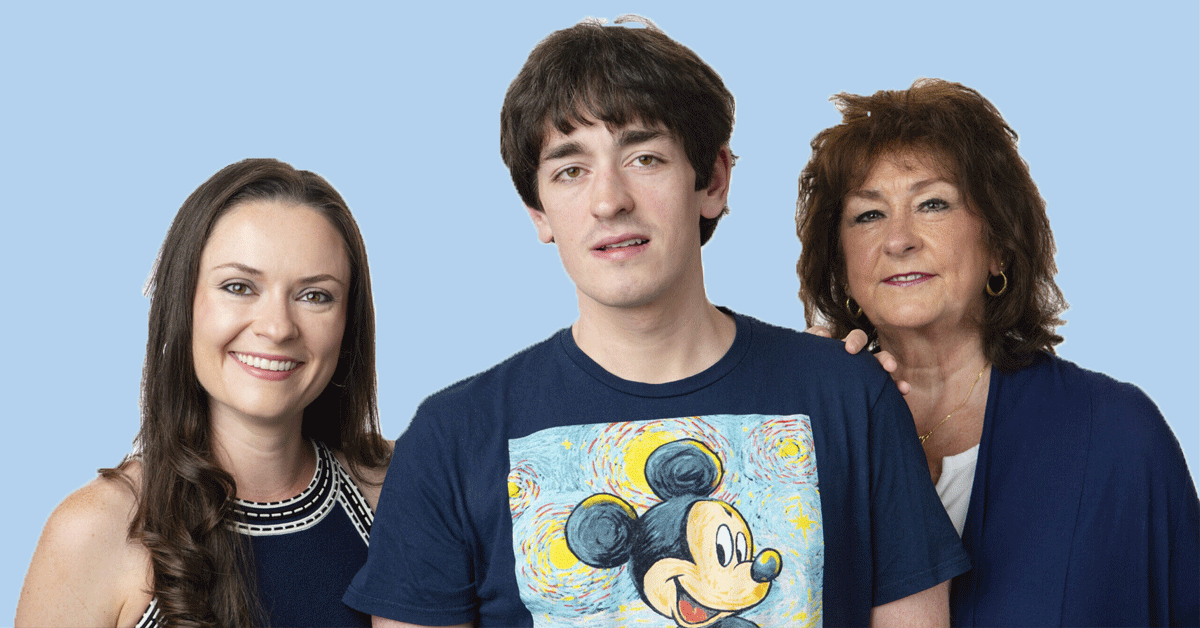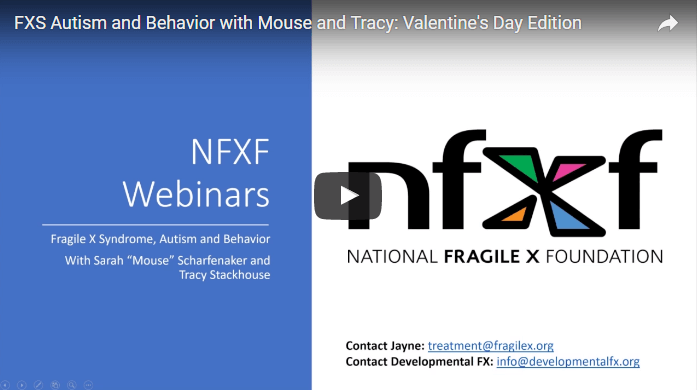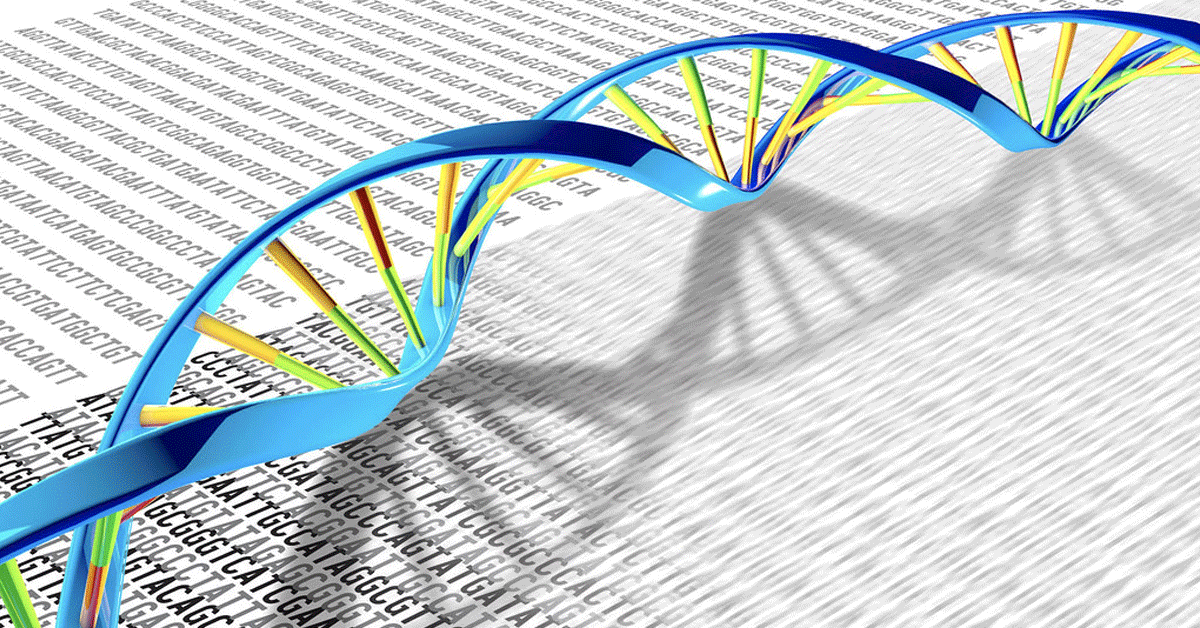What is Autism?
Autism is a spectrum disorder, which means there’s a wide range of lifelong symptoms that vary in form and severity, but it is generally characterized by an impairment in social interaction and communication, and the presence of restricted and repetitive patterns of behavior, interests, or activities.
According to the CDC, autism affects an estimated 1 in 36 children and 1 in 45 adults in the United States today. On average, autism is diagnosed around age 5 in the U.S., with signs appearing by age 2 or 3, though many parents and caregivers have shared they noticed signs before their child’s first birthday. By age 2, a diagnosis by an experienced professional can be considered reliable.[1] Autism impacts every sex, age, race and ethnicity. Research from the CDC does show that boys are diagnosed with autism four times more often than girls.
Causes of Autism
There is a strong genetic component to autism. Research suggests almost 20% of younger siblings of a child with autism will receive a diagnosis themselves, which is much higher than the CDC-reported 1% to 2% risk among the general population.[2]
Researchers continue trying to determine both the genetic and non-genetic environmental factors that contribute to autism. An estimated 50% of individuals with autism have a genetic “cause”, including chromosome deletions or duplications, an identifiable syndrome or single gene condition like Fragile X.[3] There are also certain environmental influences, like advanced parental age, prenatal exposure to some contaminants, maternal factors, and birth complications, that have also been associated with autism.
Diagnosing Autism
There is no medical test, such as a blood test or brain scan, to diagnose autism. Instead, a developmental or general pediatrician, neurologist, psychologist, psychiatrist, or other specialists, will look at a child’s behavior and development to determine both the diagnosis and its severity. The standard reference used to diagnose mental and behavioral conditions — including autism — is the Diagnostic and Statistical Manual of Mental Disorders (DSM-5). There are also cases where a child does not meet the diagnostic criteria for autism but will have autistic-like features.
To meet diagnostic criteria for autism according to DSM-5, a child must have persistent deficits in each of three areas of social communication and interaction plus at least two of four types of restricted, repetitive behaviors. Learn more from the CDC at Clinical Testing and Diagnosis for Autism Spectrum Disorder.
Treating Autism
Early intervention services are important for children from birth to 3 years old and include therapy to help the child interact with others. A parent or caregiver suspecting autism or other developmental problems needs to work with their child’s doctor as soon as possible.
Treatments beyond early intervention fall into the categories of behavior and communication, dietary, medication, and complementary medicine, which may include:
- Auditory training.
- Discrete trial training.
- Vitamin therapy.
- Anti-yeast therapy.
- Facilitated communication.
- Music therapy.
- Occupational therapy.
- Physical therapy.
- Sensory integration.
Understanding Autism Spectrum Disorder in Fragile X Syndrome
Clarification on how the ASD diagnosis and FXS do and do not overlap. Understanding this distinction can be particularly helpful for genetic counseling and deciding on the most appropriate interventions.
The Fragile X Syndrome & Autism Connection
Among the genetic causes of autism, Fragile X syndrome — one of the more than 800 genes associated with autism — is the most common, known inherited single-gene disorder, and accounts for an estimated 1% to 6% of all autism cases, and according to the CDC, a national parent survey found that 46% of males and 16% of females with Fragile X syndrome have been diagnosed or treated for autism. [4]

Testing for Known Genetic Causes of Autism
Though blood tests are not part of an autism diagnosis, they come into play to rule out known genetic causes of autism. Having a genetic diagnosis in addition to an autism diagnosis can help families in several ways — including understanding the supports and treatments that may be most helpful. Autism and Fragile X syndrome are often diagnosed separately, with many children diagnosed with autism before they are diagnosed with Fragile X syndrome.
anyone with a developmental delay, intellectual disability or autism diagnosis have the Fragile X DNA (genetic) test. It is important to receive the Fragile X-specific test, as Fragile X will not be found by microarray or exome sequencing.
While FXS is the most common single gene link to autism, they are not the same thing and should not be treated as the same thing. For example, an impairment in social interaction is one of the core characterizations of autism. But since many children with Fragile X syndrome are interested in social interactions, treatments for autism that focus on the social aspect, may not be productive in the overall care for those with FXS+Autism. It is important to look at the individual and consider all associated diagnoses when making a plan for their care.
Treating FXS+Autism
Challenging behaviors that are seen in a higher proportion of children with FXS+Autism vs. those with Fragile X syndrome alone. These behaviors may include attention problems, hyperactivity and impulsivity, anxiety, and aggressive and self-injurious behaviors.
Many individuals with FXS utilize behavioral therapy, but medication can sometimes also be helpful to support speech-language, occupational, and educational therapeutic services, and to allow a child to learn in the least restrictive environment.
More intensive speech and language therapy, with an emphasis on group sessions, behavioral therapy, and augmentative technology are often indicated for FXS+Autism. Young children should also have intensive therapeutic intervention through early intervention programs. Educational strategies may need to include as much focus on daily living skills as on academics.
Learn More
Autism Spectrum Disorder in Fragile X Syndrome: Cooccurring Conditions and Current Treatment
This study examines the impact of the autism diagnosis in a large clinic-based Fragile X syndrome population to better inform the care of people with Fragile X syndrome. (Pediatrics, June 2017, Vol. 139)
FXS and Autism: Similar But Different
Clinical perspectives on the behavioral differences between Fragile X syndrome and what are thought to be core features of autism.
Similarities & Differences
FXS vs. Autism
Characteristics that have been found to differ between the behavioral presentation of Fragile X syndrome and autism include:
The frequency of intellectual disability is higher in Fragile X syndrome than in autism. Most males and about a third of females with Fragile X syndrome have intellectual disability, while only about 40% of individuals with autism have intellectual disability.
Motor coordination deficits are worse in Fragile X syndrome than autism.
Individuals with autism are more likely to show worse receptive language than expressive language, while individuals with Fragile X syndrome tend to show the opposite pattern.
Interest in socializing is higher in Fragile X syndrome in general than autism (although limited by anxiety and avoidance).
Imitation skills are better in Fragile X syndrome than autism when level of intellectual impairment is controlled.
FXS vs. FXS+Autism
Characteristics of individuals with Fragile X syndrome who meet criteria for autism (FXS+Autism) compared to individuals with Fragile X syndrome alone include:
- Less developed language skills, particularly receptive skills.
- Lower non-verbal cognition and IQ scores.
- Lower adaptive skills.
- More severe overall behavioral problems.
- Reduced interest in and motivation for social interaction or a failure to attend to social information that might promote appropriate social behavior.
- Individuals with FXS+Autism may face similar but more severe challenges than children with Fragile X syndrome.
Learn More
Making Sense of Multiple Diagnoses
When it comes to diagnosing Fragile X syndrome, there is good news and bad news. The good news is that more children than ever are being accurately diagnosed with Fragile X syndrome at an early age. The bad news is that there is a lot of confusion among parents, and even professionals, about the meaning of Fragile X in relation to other types of diagnoses that a child receives.
Behavioral Issues in FXS+Austim
The National Fragile X Foundation and our members are closely tied to autism: FXS — one of the more than 800 genes associated with autism — is the most common known single gene cause of autism, accounting for 1%–6% of all cases. Additionally, 46% of males and 16% of females with FXS have been diagnosed or treated for autism.
Here we take a look at behavioral issues in individuals with FXS plus autism and compare them to those with FXS alone.
Studies involving the impact of an autism co-diagnosis in FXS have to date relied mostly on parent-reported data and/or smaller sample populations. But thanks to the registry and longitudinal database FORWARD plus standardized clinician- and parent-reported data from 25 Fragile X clinics, we now have access to samples large enough to include a breakdown of findings by age groups.
The Impact of an Autism Co-Diagnosis on Behaviors in FXS
There are many different types of behaviors associated with ASD, regardless of ASD status and age, particularly attention issues and anxiety. In the first large scale study looking at autism in FXS, and using FORWARD and Fragile X clinic data, the charts below shows behaviors associated with FXS+Autism and FXS only, by age group (ages 3–11 and 12–21), in subjects enrolled in the FORWARD Database from September 7, 2012, through August 31, 2014.
In general, the behavioral profiles were similar in both age groups. Regardless of their relative frequency, however, hyperactivity, hypersensitivity/overreactivity, perseverative/obsessive compulsive behavior, and irritability/aggressive behavior was much higher among those with FXS+Autism versus those with FXS only. The difference between FXS+Autism and FXS was less striking for anxiety, with only the older (ages 12–21) FXS+Autism group showing significantly higher anxiety than FXS only (98% vs. 87%). As a whole, mood swings/depression problems were less common (∼18%), with no significant difference between FXS+Autism and FXS only.
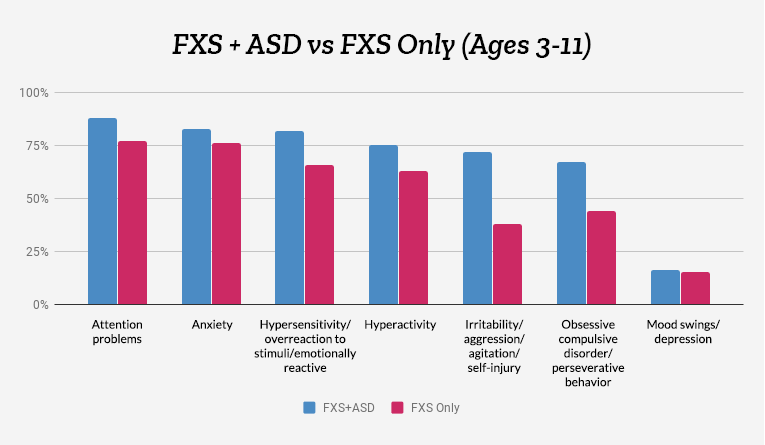

Other findings from the study included:
- FXS+Autism individuals were about 3x more likely to experience seizures.
- Sleep problems requiring treatment were found in 4 out of 10 with FXS+Autism vs. 3 out of 10 for FXS alone.
- Aggressive and disruptive behavior was treated with medication in 4 out of 10 of individuals with FXS+Autism vs. 2 out of 10 for those with FXS alone. Other behaviors were treated similarly in both groups.
Separately, FXS and autism share many overlapping issues, so it’s important to understand these differences to ensure an accurate diagnosis. Most FXS behavioral issues trace back to anxiety and hyperarousal. Autism’s behavioral roots and manifestations are more complex and multi-faceted, which makes it essential to understand the root of the behavior before committing to a treatment plan.
And while parents may be well aware of the differences between FXS, ASD, and FXS+Autism, teachers, clinicians, and other professionals, need to understand that FXS+Autism isn’t merely a sum of its parts. But if FXS is just one cause out of an unknown number for autism, how does one affect the other? Unfortunately, we don’t yet know the answer to this question.
Learn More About Autism
To learn more about autism, here are some video resources to get you started:<
We really liked Sensory Overload for its beautiful animation and how well it illustrated this common symptom of autism.
Ted Talks are great for learning about, well, most anything! Check out Ted Talks related to autism, or skip straight to the most popular talks:
- Autism—What We Know (and what we don’t know yet), from Simons Foundation geneticist Wendy Chung.
- The World Needs All Kinds of Minds, from Temple Grandin, who was diagnosed with autism as a child.
- What I’ve Learned from My Autistic Brothers, from writer Faith Jegede.
For Professionals
Diagnosing Autism in Fragile X
Intellectual disability is an important variable in considering whether autism is present within FXS. ID, a feature of FXS in most males, is common in autism but is not necessary for a diagnosis of autism, nor for FXS with autism. However, severe ID is often difficult to differentiate from autism, as it, too, includes challenges in social development and communication, and repetitive and self-stimulatory behaviors are often present.
The DSM-5 requires consideration of overall intellectual level in determining an autism diagnosis. If a child’s social communication delays are in line with their overall developmental level, then a diagnosis of autism is not warranted. In other words, social challenges must exceed those expected based on a person’s overall developmental level.
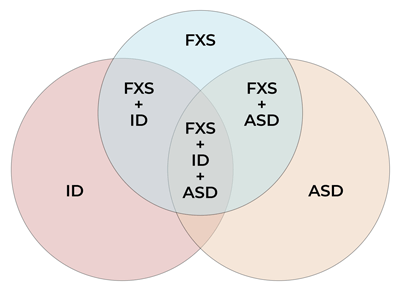
Assessment of Fragile X Syndrome — For Clinicians
Taken together, the clinical assessment of individuals with FXS must be comprehensive, accommodate the unique aspects and range of the FXS phenotype, and utilize tools that are appropriate (feasible, scorable, and valid) for use in FXS and commensurate with their developmental level.
Understanding Autism Spectrum Disorder in Fragile X Syndrome
Clarification on how the ASD diagnosis and FXS do and do not overlap. Understanding this distinction can be particularly helpful for genetic counseling and deciding on the most appropriate interventions.
Webinars
FXS and Autism
view allOctober 2, 2017
01 h 04 m
Numerous small and parent-reported studies have shown that a considerable percentage of individuals with Fragile X syndrome also carry a diagnosis of autism spectrum disorder.
February 22, 2017
01 h 14 m
Tracy Stackhouse and Sarah Scharfenaker (co-founder emeritus) of Developmental FX , join us to answer questions about Fragile X and behavior.
November 20, 2015
01 h 23 m
Hosted by Jayne Dixon Weber, Tracy Stackhouse and Sarah K. Scharfenaker (co-founder emeritus) of Developmental FX provide insight and valuable advice on autism and its relation to behavior in Fragile X syndrome.



